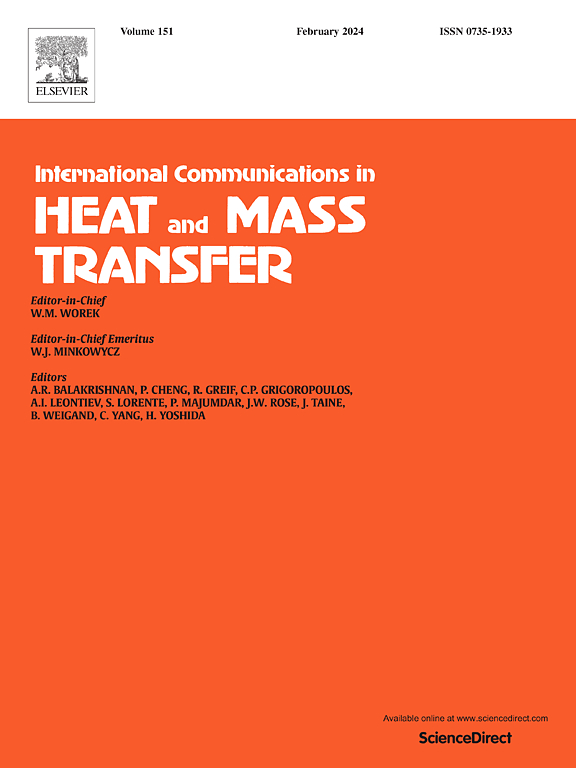有机工质在金属有机骨架和共价有机骨架中的解吸过程:分子动力学研究
IF 6.4
2区 工程技术
Q1 MECHANICS
International Communications in Heat and Mass Transfer
Pub Date : 2025-07-02
DOI:10.1016/j.icheatmasstransfer.2025.109294
引用次数: 0
摘要
工质在多孔材料中的吸附和解吸过程中,通过热能和表面能的转换,提高了工质的蓄热能力。然而,现有的研究主要集中在吸附过程,而解吸过程仍未得到充分探索。本研究采用分子动力学模拟研究了R32、R134a和R1234yf在两组不同体积比表面积的mof (IRMOF-1、IRMOF-16)和COFs (BF-COF-2、COF-108)中的解吸特性。结果表明:随着温度的升高,脱附量、脱附热和自扩散系数均增大;在相似的比表面积下,COFs的解吸性能优于mof。此外,COFs的解吸自由能相对较高。比表面积较小的多孔材料由于吸附位点较少,在解吸过程中表现出更大的优势。在R134a中加入1wt %的IRMOF-1、IRMOF-16、BF-COF-2和COF-108,在410 K时,其储热性能分别提高了1.34%、5.49%、2.36%和5.99%。由于COFs的解吸热更大,在相同比表面积下,COFs工质的储热性能优于mfs工质。本文章由计算机程序翻译,如有差异,请以英文原文为准。
The desorption processes of organic working fluids in metal organic frameworks and covalent organic frameworks: A molecular dynamics study
The heat storage capacity of working fluids can be enhanced by the conversion of thermal energy and surface energy during their adsorption and desorption processes in porous materials. However, existing studies have predominantly focused on adsorption processes, while desorption processes remain underexplored. This study employed molecular dynamics simulations to investigate the desorption properties of R32, R134a, and R1234yf in two groups of MOFs (IRMOF-1, IRMOF-16) and COFs (BF-COF-2, COF-108) with varying volume specific surface areas. The results show that the desorption capacity, desorption heat, and self-diffusion coefficient increase with temperature. For similar specific surface areas, the desorption performance of COFs is better than that of MOFs. In addition, the desorption free energy of COFs is relatively higher. Porous materials with smaller specific surface areas show greater advantages in desorption due to fewer adsorption sites. Adding 1 wt% of IRMOF-1, IRMOF-16, BF-COF-2, and COF-108 to R134a at 410 K enhanced thermal energy storage properties by 1.34 %, 5.49 %, 2.36 %, and 5.99 %, respectively. Due to the larger desorption heat of COFs, the thermal energy storage capacity of working fluids with COFs performs better than that of working fluids with MOFs at similar specific surface areas.
求助全文
通过发布文献求助,成功后即可免费获取论文全文。
去求助
来源期刊
CiteScore
11.00
自引率
10.00%
发文量
648
审稿时长
32 days
期刊介绍:
International Communications in Heat and Mass Transfer serves as a world forum for the rapid dissemination of new ideas, new measurement techniques, preliminary findings of ongoing investigations, discussions, and criticisms in the field of heat and mass transfer. Two types of manuscript will be considered for publication: communications (short reports of new work or discussions of work which has already been published) and summaries (abstracts of reports, theses or manuscripts which are too long for publication in full). Together with its companion publication, International Journal of Heat and Mass Transfer, with which it shares the same Board of Editors, this journal is read by research workers and engineers throughout the world.

 求助内容:
求助内容: 应助结果提醒方式:
应助结果提醒方式:


